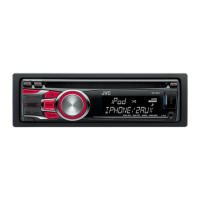Why is the elapsed playing time not correct on my JVC KD-R53?
- LLori LopezSep 12, 2025
If the elapsed playing time is not correct on your JVC Receiver, this sometimes occurs during playback due to how the tracks are recorded on the disc.

Why is the elapsed playing time not correct on my JVC KD-R53?
If the elapsed playing time is not correct on your JVC Receiver, this sometimes occurs during playback due to how the tracks are recorded on the disc.
Why does my JVC Receiver display “IN DISC”?
If the JVC Receiver displays “IN DISC”, the disc cannot be ejected properly. Ensure that nothing is blocking the loading slot.
Why does my JVC KD-R53 display “PLEASE” and “EJECT“ alternately?
If your JVC Receiver displays “PLEASE” and “EJECT“ alternately on the display, press 0, then insert a disc correctly.
Why disc cannot be played back on my JVC KD-R53 Receiver?
If the disc cannot be played back on your JVC Receiver, insert the disc correctly.
How to fix JVC KD-R53 Receiver when sound cannot be heard from the speakers?
If you can't hear any sound from the speakers connected to your JVC Receiver, first, ensure that the volume is appropriately adjusted. Also, verify that the unit isn't muted or paused. Finally, check all cords and connections to ensure they are properly connected.
Why “F-AUX” or “R-AUX” cannot be selected on my JVC KD-R53 Receiver?
If the JVC Receiver displays “F-AUX” or “R-AUX” cannot be selected, check the = setting.
Why does playback stop on my JVC KD-R53 Receiver?
If your JVC Receiver stops playback, it may be due to the headphones being disconnected during playback. Restart the playback operation.
Why does “NO FILE” appear on the display of my JVC KD-R53?
If “NO FILE” appears on the display of your JVC Receiver, check whether the device contains playable files.
Why does “READING” keep flashing on the display of my JVC KD-R53 Receiver?
If “READING” keeps flashing on the display of your JVC Receiver, a longer readout time is required. Avoid using too many hierarchical levels and folders.
Why is the sound distorted on my JVC Receiver?
If the sound from your JVC Receiver is distorted, deactivate the equalizer either on the unit or on the iPod/iPhone.
| Bluetooth | Yes |
|---|---|
| USB Port | Yes |
| CD Player | Yes |
| Display Type | LCD |
| Supported Digital Audio Standards | MP3, WMA |
| Equalizer | Yes |
| Faceplate Type | Detachable |
| Channels | 4 |
| AUX Input | Yes |
| Remote Control | Yes |
| Steering Wheel Control | Yes |
| Power Output | 50W x 4 |
| RMS Power Output | 22 Watts x 4 |
| Tuner | AM/FM |
| Media Type | USB |
Details on Class 1 laser product and user service restrictions.
Information on the caution label and laser radiation warnings when the unit is open.
Instructions for removing and attaching the detachable control panel.
Procedures for resetting the unit to factory default settings.
Steps to take if a disc cannot be ejected normally.
Guidelines for cleaning the unit's panel and surfaces.
Instructions for cleaning the unit and panel connectors.
How to disable the automatic display demonstration mode.
Step-by-step guide to setting the unit's clock.
Tips for enhancing FM signal reception and stereo effect.
How to manually store favorite radio stations.
Using SSM to automatically store strongest stations.
How to recall stored radio stations.
How to cycle through display information for radio stations.
Searching for radio stations based on program type (PTY codes).
Activating Traffic Announcement standby reception.
Activating standby reception for news programs.
Automatically tuning to stations with stronger signals for the same program.
Activating automatic station search for better reception.
Cycling through RDS information display options.
How to stop playback and eject a disc.
General operations for playing discs, including track selection.
Navigating and selecting tracks or folders on MP3/WMA discs.
Choosing repeat or random playback modes.
Cycling through disc playback information displays.
Overview of using external components via auxiliary inputs.
How to connect devices to the front auxiliary input.
How to connect devices to the rear auxiliary input.
Choosing the operating mode for iPod/iPhone connection.
Fundamental operations for controlling iPod/iPhone playback.
Navigating menus to select desired tracks on iPod/iPhone.
Choosing repeat or random playback options for iPod/iPhone.
Cycling through playback information displays for iPod/iPhone.
Choosing predefined sound modes for different music genres.
Saving personalized sound settings as a custom mode.
Configuring demonstration mode, clock, and dimmer settings.
Adjusting display brightness, equalizer, and audio output settings.
Configuring tuner-related features like SSM and AF-REG.
Managing available audio source selections for the unit.
Solutions for general unit problems and radio reception issues.
Resolving problems related to disc and digital file playback.
Diagnosing and fixing problems with USB device playback.
Resolving common issues encountered during iPod/iPhone playback.
Further tips and compatibility information for troubleshooting.
Steps for registering (pairing) Bluetooth devices with the unit.
Instructions for using a Bluetooth mobile phone for calls and voice.
How to stream audio from a Bluetooth device.
Technical details of the unit's audio amplifier section.
Technical details of the CD player section.
Technical details of the FM/AM tuner section.
Technical details for USB interface and general unit parameters.
